DNR News** Archived Article - please check for current information. **
FAQs: Native aquatic plants spreading in Lake Murray coves June 20, 2018
By Chris Page, Program Manager, SCDNR Aquatic Nuisance Species program

Image and drawing (below) of Southern naiad are courtesy of the University of Florida/IFAS Center for Aquatic and Invasive Plants.

What is the “Mystery Plant” that people have been seeing in Lake Murray?
If you live on Lake Murray or have boated on the lake recently, you may have seen aquatic plants ringing some of the shoreline. The plants grow rooted in the bottom and exists in the lake from the depth of 5 feet to about 15 feet deep. Have no fear, it is not the dreaded hydrilla. These are native plants that are found commonly throughout the Southeast. One of the plants is Najas guadalupensis, more commonly known as Southern naiad. It is an annual with long stringy stems. The other is Potamogeton pusillus, or slender pondweed.
Southern naiad vegetation and seeds are a primary food source for many waterfowl and provide food for the many invertebrates which power the food chain for fish and other wildlife species on the lake. On the other hand, if you are a recreational user of the lake, you probably consider it a very big problem. Both of these plants can be a nuisance for swimmers, jet skiers, and boats with props. The floating sections of these weeds are most likely caused by boats, wave action, or triploid grass carp eating it and pulling it up.
What can be done about it?
There are sterile triploid grass carp in Lake Murray and several other lakes in the state. They were stocked to provide control for the invasive species hydrilla, but they will also eat some other species when hydrilla is not present, like Southern naiad and slender pondweed.
Why are the carp not eating it?
They are, but the numbers of triploid grass carp in the lake are currently lower than needed. In 2015, with the major flooding that occurred, SCE&G had to open the flood gates, and we lost almost all the triploid grass carp in the lake as they swam through the gates downstream. Many washed up into the Saluda Shoals parking lots. Stocking efforts in 2016, 2017 and 2018 are only now getting the triploid grass carp population back up to the levels needed for maintenance control of hydrilla, but populations are still not high enough to significantly impact native species.
What is the most effective way to give homeowners and lake users relief from this problem?
You can physically rake this vegetation to the shoreline to remove it from the lake, but the simple answer to address the problem on a wider scale is to do a winter drawdown at 4- to 5-year intervals to a level 10-15 feet below full pool. SCE&G manages the water level on the lake based on their Federal Energy Regulatory Commission (FERC) license and will have to make that commitment. Herbicides can be effective, but they are expensive and only give short term relief to the problem. Another drawback to herbicide use can be water restrictions for irrigation and potable water intakes, especially on Lake Murray, where there are many unregistered intakes.
Calls concerning vegetation and lake levels can be directed to the SCE&G Lake Management Office. The S.C. Department of Natural Resources will continue to help local utilities with aquatic plant issues by providing cost share programs and/or expertise. The SCDNR, as a natural resource agency, tries to balance the uses of any public water body in ways that benefit not only hunters and anglers, but also homeowners, recreational users, public drinking water suppliers and other users.
DNR Media Contacts
| Area | Personnel | Number |
|---|---|---|
| Coastal | David Lucas | 843-610-0096 |
| Marine | Erin Weeks | 843-953-9845 |
| Midlands | Kaley Nevin | 803-917-0398 |
| Upstate | Greg Lucas | 864-380-5201 |
After Hours Radio Room - 803-955-4000
